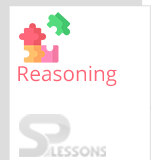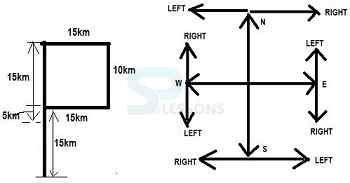 Introduction
Introduction
What is Reasoning Ability Test?
A logical reasoning test is a form of psychometric testing that is widely used by corporate employers to help assess candidates during their recruitment process. 'Psychometric' is just a fancy way of saying 'measuring mental ability' and logical reasoning tests are designed to measure your non-verbal skills.
The article IBPS RRB Reasoning Ability Quiz 2 provides Reasoning Ability questions with answers useful to the candidates preparing for Competitive exams, Entrance exams, Interviews etc. IBPS RRB has released IBPS RRB Officer 2019 Official Notification for Officer Scale(I, II, and II). Reasoning Ability plays major role to qualify examination. The article IBPS RRB Reasoning Ability Quiz 2 will assist the students understanding of the type of questions expected from the topic Reasoning Ability. The online examination Preliminary is scheduled to be conducted on [latex]{3}^{rd}[/latex], [latex]{4}^{th}[/latex] & [latex]{11}^{th}[/latex] August, 2019 (Tentatively), Mains exam is scheduled to be conducted on [latex]{22}^{nd}[/latex] September 2019.
 Quiz
Quiz
Direction(1-5): In each of the questions below consists of a question and two statements numbered I and II given below it. You have to decide whether the data provided in the statements are sufficient to answer the question. Read both the statements and give answer.
- (A) If the data in statement I alone are sufficient to answer the question, while the data in statement II alone are not sufficient to answer the question
- (B) If the data in statement II alone are sufficient to answer the question, while the data in statement I alone are not sufficient to answer the question
- (C) If the data either in statement I alone or in statement II alone are sufficient to answer the question
- (D) If the data given in both statements I and II together are not sufficient to answer the question and
- (E) If the data in both statements I and II together are necessary to answer the question.
- A. I alone is sufficient while II alone is not sufficient
B. II alone is sufficient while I alone is not sufficient
C. Either I or II is sufficient
D. Neither I nor II is sufficient
E. Both I and II are sufficient
- A. I alone is sufficient while II alone is not sufficient
B. II alone is sufficient while I alone is not sufficient
C. Either I or II is sufficient
D. Neither I nor II is sufficient
E. Both I and II are sufficient
- A. I alone is sufficient while II alone is not sufficient
B. II alone is sufficient while I alone is not sufficient
C. Either I or II is sufficient
D. Neither I nor II is sufficient
E. Both I and II are sufficient
- A. I alone is sufficient while II alone is not sufficient
B. II alone is sufficient while I alone is not sufficient
C. Either I or II is sufficient
D. Neither I nor II is sufficient
E. Both I and II are sufficient
- A. I alone is sufficient while II alone is not sufficient
B. II alone is sufficient while I alone is not sufficient
C. Either I or II is sufficient
D. Neither I nor II is sufficient
E. Both I and II are sufficient
Direction(1-2): Study the following information carefully and answer the questions given below:
‘A $ B’ means ‘A is father of B’
‘A # B’ means ‘A is wife of B’
‘A @ B’ means ‘A is brother of B’
‘A % B’ means ‘A is daughter of B’
1. P @ R $ J # T indicates what relationship between P and J?
- A. J is sister of P
B. J is nephew of P
C. J is niece of P
D. Cannot be determined
E. None of these
- A. O is father of F
B. G is brother-in-law of P
C. P is sister of F
D. F is mother-in-law of P
E. Cannot be determined
- A. 8%N
B. 8*N
C. 17#N
D. 16#N
E. None of these
- A. ROSE
B. REVERSE
C. RUPEE
D. RANDOM
E. None of these
- A. 20%K
B. 26%K
C. 28!K
D. 24!K
E. None of these
1. Nishu starting from a fixed point goes 15 km towards North and then after turning to his right he goes 15 km. Then he goes 10, 15 and 15 metres after turning to his left each time. How far is he from his starting point?
- A. 5 metres
B. 10 metres
C. 20 metres
D. 15 metres
E. Can not be determined
- A. GNPSFQ
B. GNORFR
C. EGOPRF
D. FMORFP
E. None of these
- A. RJRUDODL
B. SJRUOFDFM
C. LRDSGDDS
D. RKSTEOEL
E. None of these
- A. 32
B. 35
C. 33
D. 34
E. None of these
- A. 23
B. 26
C. 25
D. 22
E. None of these
Other Articles
 Study Guide
Study Guide
 Exams
Exams
| Competitive Exams - College Entrance Exams | |||
|---|---|---|---|
| Category | Notification | ||
| Diploma | HPBOSE D.El.Ed CET 2019 | Goa Diploma Admissions 2019 | |
PG |
GATE 2020 |
ATMA 2019 |
XAT 2020 |
| Click Here For – All India Entrance Exam Notifications | |||
 Daily CA
Daily CA
 Job-Alerts
Job-Alerts
 SP Quiz
SP Quiz
| Competitive Exams - Practice Sets | |
|---|---|
| Category | Quiz |
| Quant Aptitude | Profit and Loss |
| Reasoning Ability | Seating Arrangement |
| Insurance Awareness | Insurance Awareness |
 GK
GK
| General Knowledge for Competitive Examinations | |
|---|---|
| Topic | Name of the Article |
| GK - World | Important Books Authors |
| Important Newspapers | |
| GK - India | NIRF Rankings 2019 |
| Disaster Management in India | |
| GK - Abbreviations | Insurance Domain Abbreviations |
| Finance Abbreviations | |
| GK - Banking & Insurance | Basel Norms – Banking System |
| Negotiable Instruments | |
| GK - Science & Technology | Human Body Facts |
| Indian Space Centers | |
| IBM IIT Bombay AI Research | |




